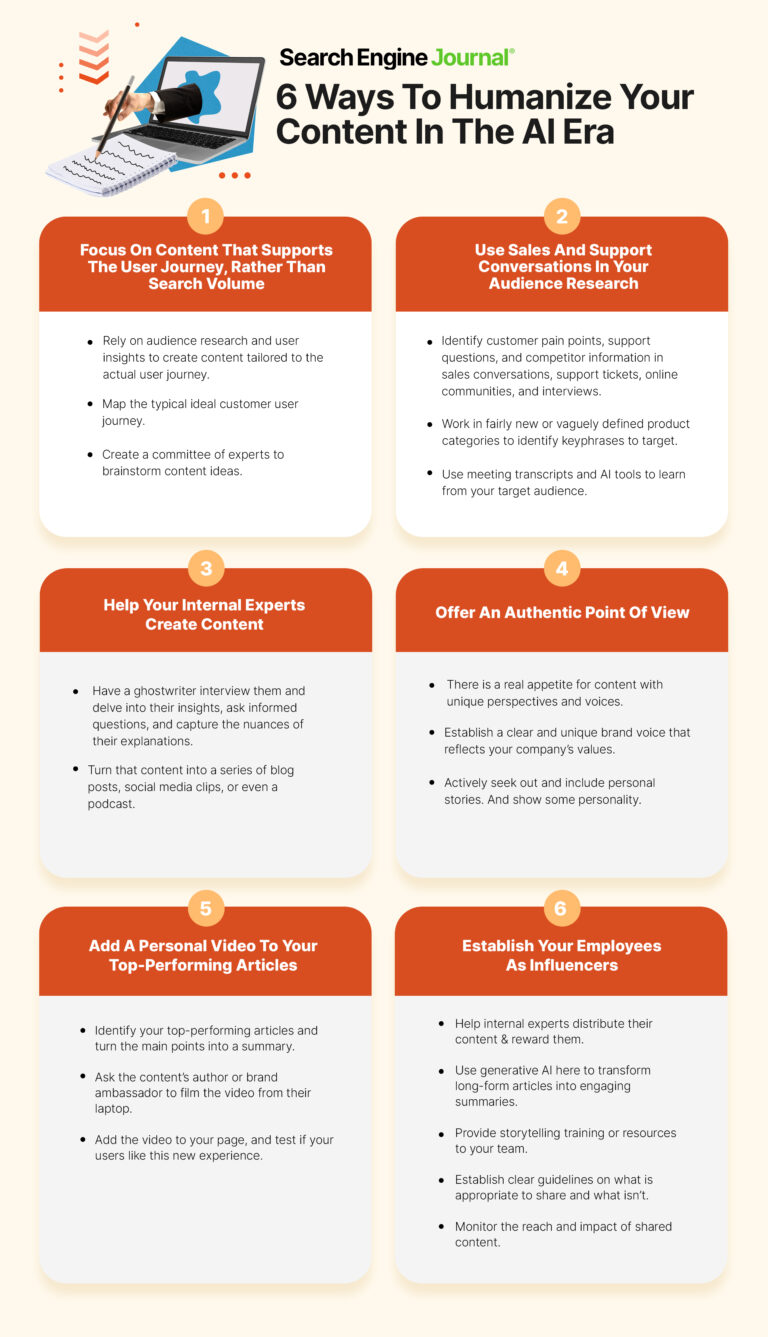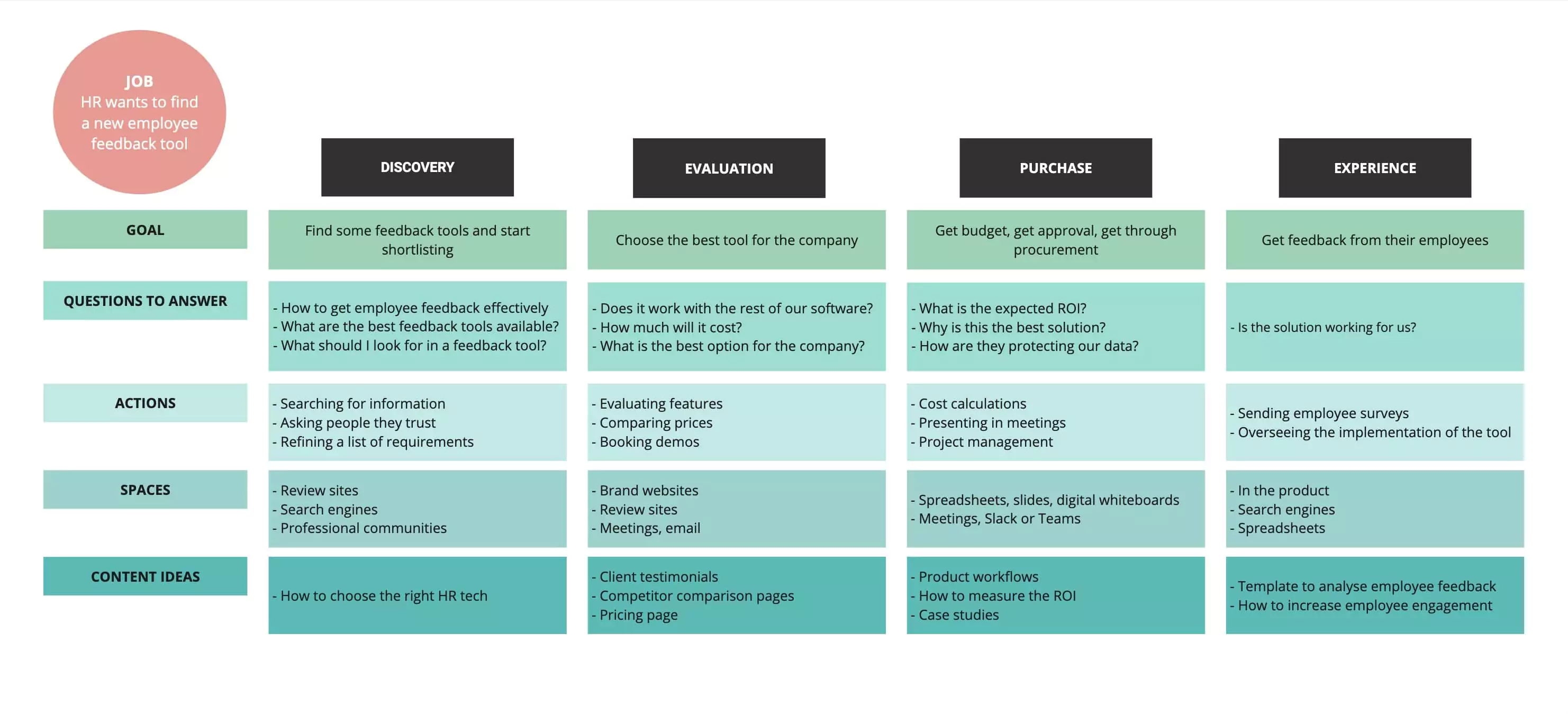In a world where anyone can create any content using AI without being an actual expert, it has become difficult for users to trust online content.
This trend is evident in the increasing preference for sourcing real human experiences and opinions on social media platforms – such as adding [reddit] at the end of search queries or using TikTok or Instagram as a search tool – despite skepticism towards influencer content.
People are seeking to connect with other people more than ever.
While some companies will make the mistake of pivoting entirely to AI-generated content to reduce costs, others can use this as an opportunity to become more human and connect deeply with their audiences.
A Human Touch Is Key In The AI Era
Generative AI is significantly influencing SEO and content trends. Being able to generate content at scale is no longer a competitive advantage.
Brands are going to have to pivot their strategy towards a more customer-centric approach by:
- Getting to know their audience better and start creating content that focuses on real customer needs and pain points rather than on search volume or product features.
- Leveraging real experts as their content creators, elevating their first-hand experience to create truly helpful content from a trustworthy source.
- Using their internal experts as brand ambassadors for their company and including them in their content distribution strategies.
You can absolutely use AI to take some work off your plate, increase your productivity, and humanize your content strategy as a brand differentiator.

1. Focus On Content That Supports The User Journey, Rather Than Search Volume
Before generative AI changed the economics of content marketing by making content generation cheap and easy for all, the smartest approach to content marketing for brands was creating content at scale.
Brands would write about any and every keyword that was even remotely related to their product. Now that anyone can do this, we need a new strategy.
It’s time to pivot away from search volume and towards content that resonates deeply with the audience and offers unique insights.
Brands need to rely on audience research and user insights to create content that’s much more tailored to the actual user journey.
Working at Sanity, I realized that simply creating content that our audience was looking for was not enough. We had to meet them during their buying journey.
The issue was that buying a headless CMS takes several months and many different people.
After tons of research, once we identified our main decision-maker, we decided to focus on creating content for that specific persona that helped them with their task at hand.
A good way to do this is by applying the Jobs To Be Done framework and mapping the typical user journey of your ideal customer.
Create a committee of experts to brainstorm ideas of content that could help your ideal customer with their task.
For example, imagine you work for a survey tool.
During your user research, you realize that a key use case for your product is employee feedback surveys, and HR teams are looking for providers they can partner with. This is what the content ideation could look like:
 Image from Miro, January 2024
Image from Miro, January 2024You can use this Miro template to guide you in your content ideation meeting.
2. Use Sales And Support Conversations In Your Audience Research
Understanding your audience will help you create content that enables you to connect with them more deeply.
Your company probably has a wealth of information about how your users interact with its products that you can tap into as part of your audience research.
Companies often interact with their customers in sales conversations, support tickets, online communities, or market research interviews.
You can use these interactions to identify the pain points your product solves, common support questions, how you compare to your competitors, and where your target audience finds you.
Working in product categories that are fairly new or vaguely defined, I’ve used this strategy to identify the keyphrases that real customers were using to talk about our product.
Targeting these keywords in our SEO strategy helped us reach a wider audience. Talking to them using their own words communicated something very powerful: “We get it, we understand you.”
You can use meeting transcripts and an AI tool of your choice to find the pain points your audience cares about, how you compare to competitors, common points of friction using your product, or extract the keyphrases your audience uses most often when talking about your product.
Different paid tools do this at scale, like the Google Natural Language API or MonkeyLearn. They vary widely in price, from free APIs to expensive enterprise tools.
You can also do this yourself with some beginner coding skills using KeyBERT, a free keyword extraction system, or follow this guide to entity and sentiment analysis for SEO by Lazarina Stoy.
Some user research tools like Chorus or Dovetail already incorporate some AI capabilities to identify these.
Meeting recorders like Descript, TL;DV, or Fathom can be used for this purpose, too.
3. Help Your Internal Experts Create Content
Working with your internal experts will help you communicate the real expertise of your brand and enable you to create unique high-quality content faster.
You can find incredible subject matter experts within your own team, but they’re usually too busy doing their jobs to write content for the marketing department.
Instead of missing out on their knowledge, you can work with a ghostwriter to interview your internal experts.
The ghostwriter should act not just as a writer but as a facilitator who translates your experts’ knowledge into engaging content.
They should conduct interviews that delve into the expert’s insights, ensuring the content truly reflects their expertise and tone, ask informed questions, and capture the nuances of their explanations.
One interview can turn into a series of blog posts, or be repurposed into social media clips or even a podcast.
Invite your subject matter expert to give feedback along the way. Start by creating a comprehensive content brief based on what your audience will want to know about the topic.
Then have the expert review the brief and add any missing elements or correct inaccuracies.
Once the content has been created, your internal expert should provide a final review before the content goes live.
In my experience, this collaboration requires very little time from your internal experts; five to 10 minutes for the initial review of the brief, 30 to 60 minutes for the interview, and 10 to 20 minutes for the final review.
4. Offer An Authentic Point Of View
While maintaining a brand voice is important, letting your authors’ voices and personalities shine through will make your content more colorful and engaging to an audience seeking human connection.
There is a real appetite for these unique perspectives and voices.
Google recently launched a new SERP feature, “Discussions and Forums,” to highlight real user experiences in review searches.
In 2023, it launched Perspectives, a new type of SERP that brings out personal experiences by combining videos, social media posts, and news.
In the past year, Google has been testing adding author names to articles and top stories in different ways.
Here are some tactics that will help you provide an authentic point of view:
- Establish a clear and unique brand voice that reflects your company’s values and personality. This voice should be consistent across all content but flexible enough to allow individual authors’ personalities to shine through.
- Develop content guidelines that encourage authors to infuse their own voices and personalities into their writing. This could mean allowing them to share personal anecdotes, express their opinions, or write in a style that reflects their unique way of communicating. These guidelines should balance maintaining the overall brand voice with the freedom to express individual perspectives.
- Actively seek out and include personal stories and experiences from your team and clients in your content. This could be in the form of case studies, interviews, guest posts, or featured quotes that add a human touch to your content.
- Provide training or resources to your team on effective storytelling. Teach them how to weave personal experiences and anecdotes into content in a way that enhances the message without detracting from the professionalism and goals of the piece.
An easy way to stand out from the rest of the pack is to offer a strong, unique, and authentic point of view.
Don’t be afraid to be prescriptive in your content or incorporate personal stories from your team or your clients.
5. Add A Personal Video To Your Top-Performing Articles
People love people. That’s one of the many reasons for TikTok’s resounding success: being told a story is much more engaging than reading an article.
You don’t need a brand-new content strategy; you can repurpose your top-performing articles into a video format.
To try this out, identify your top-performing articles and create a script that summarizes the main points of the piece.
You can ask the author of the piece to film the video from their laptop, do it yourself, or work with your company’s brand ambassador if you have one.
Add the video to your page, and don’t forget to test if your users like this new experience. If they do, you can invest in rolling it out to other pages.
This can enrich your existing articles and give you the opportunity to rank with your videos by using structured data for video on your page or posting your video on third-party sites like YouTube or TikTok.
A big point of friction that comes up in this process can be creating the script.
AI can actually be an excellent ally for this! You can paste your article into ChatGPT or other tools and ask it to provide a script for a video summary. Edit it to match your brand voice, and now all that’s left is finding someone in your team who isn’t camera-shy!
Editing the video can be another big hurdle. And again, AI can help.
There are a few AI video editors in the market that automatically remove awkward silences and filler words, create engaging thumbnails, and can help you add in the intro and outro scenes.
6. Establish Your Employees As Influencers
Before I get into this recommendation, let me get something out of the way: Unless it’s in their contract or you’re paying them for it, employees are under no obligation to share your brand’s content.
Another huge advantage of working with your internal experts to create content is that they will want to share content on their own platform.
It makes them look good, it helps them build their personal brand, and they are probably proud of their latest article.
If they love the content under their name, they will want to share it with the world.
But your subject matter experts might not be social media. Here are some tips to make this strategy work.
- Help your internal experts distribute their content by offering to write an X (Twitter) thread or LinkedIn post that they can edit and publish on their social profiles.
- Use generative AI here, too, to help you transform longform articles into engaging summaries that leave you wanting more and get your audience to click through.
- Make sure to reward the employees who participate in this program by re-sharing their content and publicly recognizing their efforts. Measure the impact of their contributions and thank them for it in public company channels like Slack or an all-hands meeting.
- Offer an optional social media workshop that participating employees can join to learn how to grow and expand their personal brand.
- Establish clear guidelines on what is appropriate to share and what isn’t, putting emphasis on inclusive language and protecting client information.
- Use social media analytics to monitor the reach and impact of shared content. This data can help you understand the type of content that connects with your audience the most and refine your strategy.
In Summary
The increasing presence of AI is accelerating a growing skepticism among users toward content that misses a human element.
Why do users gravitate towards platforms like Reddit, Instagram, and TikTok? Because of their deep-seated desire for real human connections and content that genuinely resonates.
The real challenge for brands isn’t just keeping pace with AI’s relentless march forward, it’s embracing the human elements that lead to genuine connections and earn trust.
Brands should prioritize authenticity, center strategies around the user, and harness the rich, unique perspectives and experiences of real individuals.
That’s how they can create content that doesn’t just capture the audience’s attention but resonates deeply and has a lasting impact.
In the AI era, the human touch isn’t just a nice-to-have; it’s essential.
More resources:
- Interactive Content: 10 Types To Engage Your Audience
- 11 Social Media Content Types And Examples
- Content Marketing: The Ultimate Beginner’s Guide
Featured Image: Prostock-studio/Shutterstock





